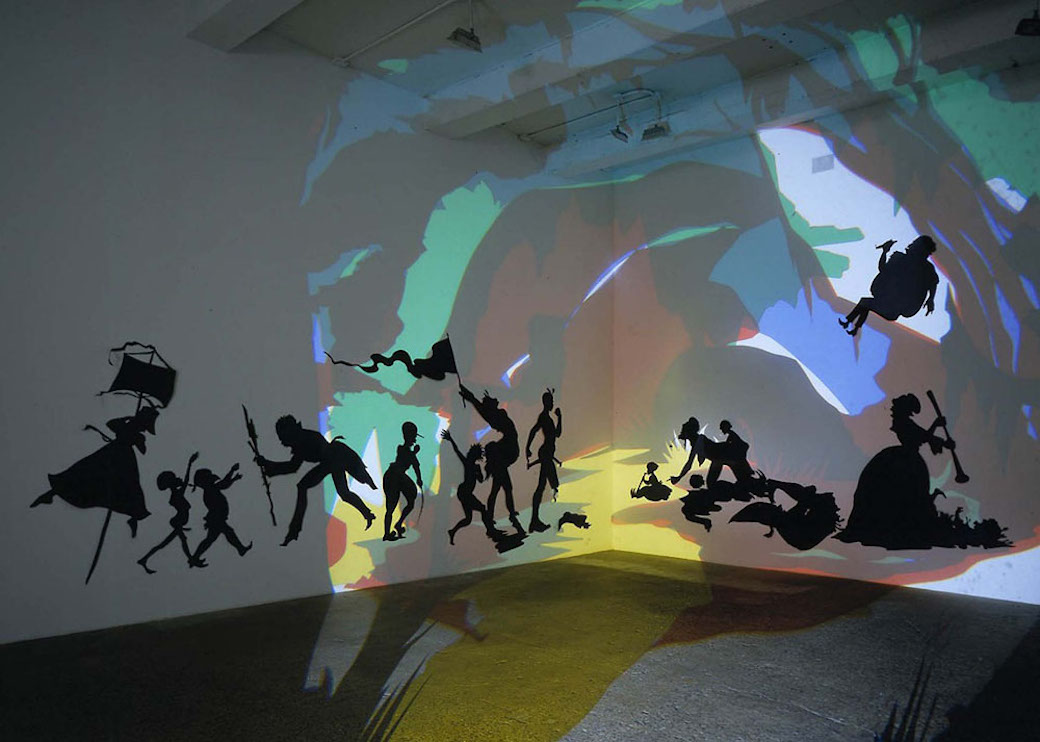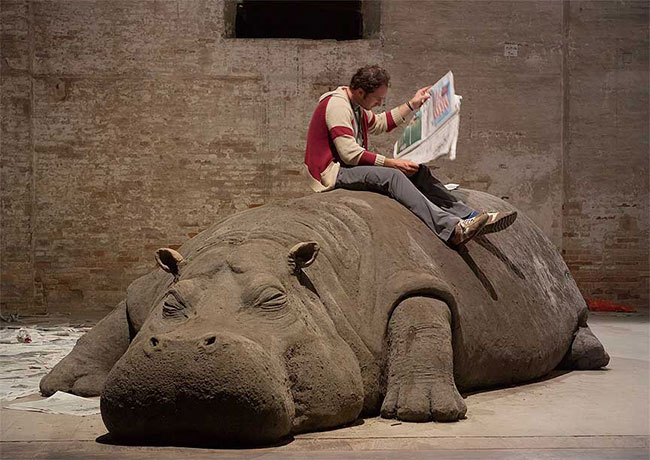
Eugene Delacroix. Liberty Leading the People, 1830. Oil on canvas; 102.4 in × 128.0 inches. Collection: The Louvre.
We typically think of revolution in grand terms, closely aligned with dramatically heroic historical paintings such as Eugene Delacroix’s Liberty Leading the People (1830) or Emanuel Gottlieb Leutze’s Washington Crossing the Delaware (1851). Such depictions crystallize our notions of how change happens and how history is made. As a counterpoint to this, I asked four alumni of the ART21 Educators program to share what they felt constituted a small revolution in their classrooms as the result of teaching with contemporary art. Their responses represent the small and often invisible shifts that have the power to radically transform education.
Expand the Canon
Ryan Schmidt, elementary art teacher
South Shore Pre-K–8, Seattle, WA

Kara Walker. Darkytown Rebellion, 2001. Installation view: Sikkema Jenkins & Co., New York. Projection, cut paper and adhesive on wall; 14 x 37 1/2 feet. Collection of Foundation Musée d’Art Moderne Grand-Duc Jean, Luxembourg Courtesy Sikkema Jenkins & Co., New York.
Growing up, my teachers talked about art in the past tense; they were obsessed with the masters of eras past—all white and all male. I internalized this and initially taught a curriculum with that same narrow perspective on art. I now work in a low-income, diverse school setting with students who don’t see themselves reflected in the art world as traditionally taught. Using ART21 videos, I introduced social justice topics including racism, sexism, and identity to sixth- through eighth-grade students, through artists like Kara Walker and Kerry James Marshall. Their work opened up conversations about issues that my students could relate to. Knowing that there are artists who have stories similar to their own, my students were more inspired to create work and share their feelings about art.
Inspire Individuality
Linda Churchwell-Varga, elementary humanities teacher
New City School, St. Louis, MO

Allora & Calzadilla. Hope Hippo, 2005. Mud, whistle, daily newspaper, and live person; approximately 16 x 6 x 5 feet. Installation view: 51st Venice Biennale. Courtesy the artists.
Last year, two of my students wrote a research paper on the terracotta warriors of Qin, the first Chinese emperor. They were then asked to respond artistically to what they had learned. The two students worked together to create a miniature terracotta warrior, which was predictable. Their artistic response was not only uninspired but also literally a flop, as the clay figure would not stand up. Before tackling the project again, these two students viewed artistic responses to history by Allora & Calzadilla, Do Ho Suh, and El Anatsui and were inspired to pursue projects that honored their personal interests and personalities. The more gregarious of the two invited pre-K through sixth-grade students to design paper dolls as visions of themselves, immortalized for the future; she then assembled and displayed this paper-doll army. Focusing on design and theater, the second student sewed a warrior costume and scripted a performance in which she was a terracotta warrior. For these students to harness their individuality within the confines of a final project in social studies felt like a little revolution—a success story of academic artistic expression that I continue to use as a touchstone.
Make Connections
Renee Bareno, high school visual art teacher
Aaron School, New York, NY

Leonardo Drew. Number 80, detail, 2002. Cast paper; installation dimensions variable. Photo: Aaron Igler/Courtesy of The Fabric Workshop and Museum. Courtesy the artist and Sikkema Jenkins & Co. © Leonardo Drew
When planning my studio-art class, I get really excited about implementing all sorts of new practices and introducing contemporary themes and artists to my students. But the first meeting in class reminds me to dial back my expectations. My students are wonderful kids with special needs, learning differences, and learning disabilities. It’s important for me to remember not what I am going to feed them but rather to focus on what they are going to retain, own, and share with me in surprising and unexpected ways. I approach teaching in the same way that I approach my own painting: it’s best not to overly plan and anticipate outcomes. Helping students find a connection is what I am really striving for. When my students discover a real-life personal connection to the work of Ai Weiwei, for instance, or Leonardo Drew and can speak about their work from a place of true understanding, then I have done a good job in guiding them.
Create Fissures
Dillon Paul, media-art teacher
Flushing International High School, Flushing, NY

Gabriel Orozco. Well, 2002. Fuji crystal chromogenic archive C-print; 33 3/4 x 46 3/4 inches. Edition of 3. Courtesy the artist and Marian Goodman Gallery, New York.
Young people mostly try to fit in rather than stand out. As an educator, it’s my job to create an environment that feels safe enough for students to push the boundaries, take chances, speak out, and dare to be different. I find that showing work by contemporary artists is a great way to get students to see beyond their own sense of limitations. I share the works of Krzysztof Wodiczko and Kara Walker to encourage new ways of thinking about storytelling, Ai Weiwei to open a conversation about art and politics, and El Anatsui, Gabriel Orozco, and Sarah Sze to debate the relevance and meaning of materials. I see my students’ eyes widen, their brows furrow—questions (small, mental firecrackers) being formed. These experiences with art and artists create a fissure in the protective gear that adolescents learn to wear, and it’s within these moments that I see the possibility for personal revolution.



